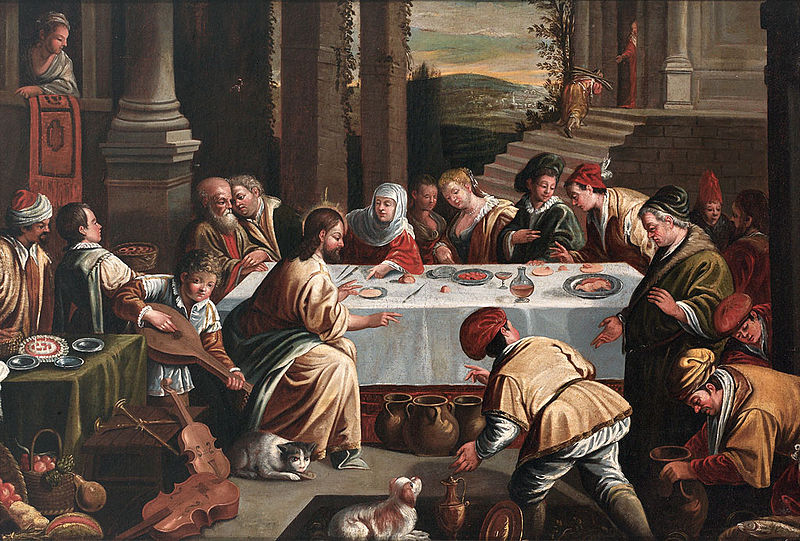I once asked a group of people with no church contact over dinner what they thought of the Gospel account of the Wedding at Cana. [1]John 2:1-12 Their responses were interesting. They didn’t really engage with the details of the story: one said something about how economically useful it would be to be able to turn water into wine, and an 18 year-old asked; “Why does the church always talk about Jesus’ miracles – what’s the use of that?”

It made me realise, among other things, that the task of interpreting the scriptures is vital: that it’s not enough just to read them out, or even to read them alone. For some scriptures that’s an even more important task than others: the stories in the synoptic gospels, Matthew, Mark and Luke are often pretty straightforward. But when you come to John, it’s a different story altogether. John’s gospel is represented by an eagle in church history: perhaps because the creature is supposed to be able to stare into the Sun: John’s gospel aims like the eagle flying high to pierce the mysteries of God. There is an almost dreamlike air in some of the stories: and hidden symbolism which means in some cases the text may be over-interpreted.
“Why does the church always talk about Jesus’ miracles – what’s the use of that?”
For example, there’s no end of biblical commentary on the meaning behind the 153 fish that were pulled out of the sea during one of Jesus’ resurrection appearances, and no-one agrees. But the story of the Wedding at Cana does feel genuinely freighted with significance. The wedding, and the turning of water into wine takes place on the third day, which calls to mind another third day when despair was turned to rejoicing.
And then there are the six stone jars, is that something to do with the six days of creation, preceding the holiest day, God’s day? Jesus speaks to his mother rather sharply: and it could seem rude to Mary, but by speaking of his ‘hour’ we can feel the shadow of the cross falling over the scene. And he does the miracle anyway. And he doesn’t do it like turning the 5 loaves and 2 fish, something that was already there, into more of the same. No, it’s something entirely new: not simply refilling the wine skins but transforming the purpose of the water used to purify those going to worship at the temple.
So there’s much we can take away from it: and perhaps the most obvious being simply that of joy. That this was a wedding that almost became a non-event were it not for a rather special guest who changed it into the best wedding anyone had ever been to. Which is, I imagine, why it’s often used at Weddings: although not as often as you might think, perhaps because of the same problem as that I encountered over the dinner table.
People just don’t quite get what to make of it. One way you can approach this, and many other texts, is to use your imagination. I decided to use this approach myself, and in a quiet moment, imagined myself at the scene. Where was I? Well, I was the bride, just discovering to her dismay that the wine had run out, and being cross with her new husband for failing to plan. Which told me rather more about myself than about Jesus.
But I also saw other things too: that Jesus didn’t just wave a proverbial magic wand over empty jars. He got other people involved in the miracle: water doesn’t leap up from wells and into water jars – it requires quite a bit of effort.
And I also wondered if this sign was welcomed. I wonder how many people would have said – ‘What a ridiculous amount of wine – is he trying to get us all drunk?’ And ‘I don’t like this new wine – I much prefer the stuff they served at the start’. And ‘What on earth are they doing using those jars to serve wine out of? That’s sacrilege – they are supposed to be used only in the temple!’ and ‘this isn’t the usual way we do things at weddings – you’re supposed to serve the best wine at the start’.
And of course, there would have been the probable majority, who didn’t know that anything special was going on, and were just enjoying a great party. And behind all this is Jesus: who knows he will be misinterpreted, who knows his grace will be rejected or used and taken for granted or exploited, and who carries on loving anyway.
We are called to follow the one who loves lavishly, who pours out his life for us unstintingly.
That is the one we are called to follow; the one who loves lavishly, who pours out his life for us unstintingly, who loves to transform our weakness and failure into his opportunities to extend grace to us, and help us to become like him.
In her book Travelling Mercies, Anne Lamott tells the story of a miracle she sees at her church, involving a man called Ken who was dying of AIDS, and whose partner had already died of the disease.
‘There’s a woman in the choir named Ranola who is large and beautiful and jovial and black and as devout as can be, who has been a little standoffish toward Ken… She was raised in the South by Baptists who taught her that his way of life – that he – was an abomination…
She was raised in the South by Baptists who taught her that his way of life – that he – was an abomination…
But Ken has come to church almost every week for the last year and won almost everyone over. He finally missed a couple of Sundays when he got too weak, and then a month ago he was back, weighing almost no pounds, his face even more lopsided, as if he’d had a stroke. Still, during the prayers of the people, he talked joyously of his life and his decline, of grace and redemption, of how safe and happy he feels these days.
So, on this one particular Sunday, we sang ‘Jacob’s Ladder’ which goes, ‘Every rung goes higher, higher’, while ironically Ken couldn’t even stand up. But he sang away sitting down, with the hymnal on his lap. And then when it came time for the second hymn, we were to sing ‘His eye is on the sparrow’. The pianist was playing and the whole congregation had risen-only Ken remained seated, holding the hymnal in his lap – and we began to sing, ‘Why should I feel discouraged? Why do the shadows fall?
And Ranola watched Ken rather sceptically for a moment, and then her face began to melt and contort like his, and she went to his side and bent down to lift him up – lifted up this white rag doll, this scarecrow. She held him next to her, draped over and against her like a child while they sang. And it pierced me.”
Jesus took the ordinary and made it extraordinary.
Jesus took the ordinary and made it extraordinary, just as he does in Holy Communion. And I believe he offers us the chance to be used and changed in this way as well. It might be through something very simple like fetching some water, or more complex like arranging a wedding. The key is perhaps just to do those things with our eyes, hands and hearts open; to offer ourselves, as Ranola did, to God, that he might use us in our ordinariness, and even in our weakness. To be open to seeing people, things and circumstances in different ways, and to be used too to surprise others by the grace and abundance of God.
References
| ↑1 | John 2:1-12 |
|---|


